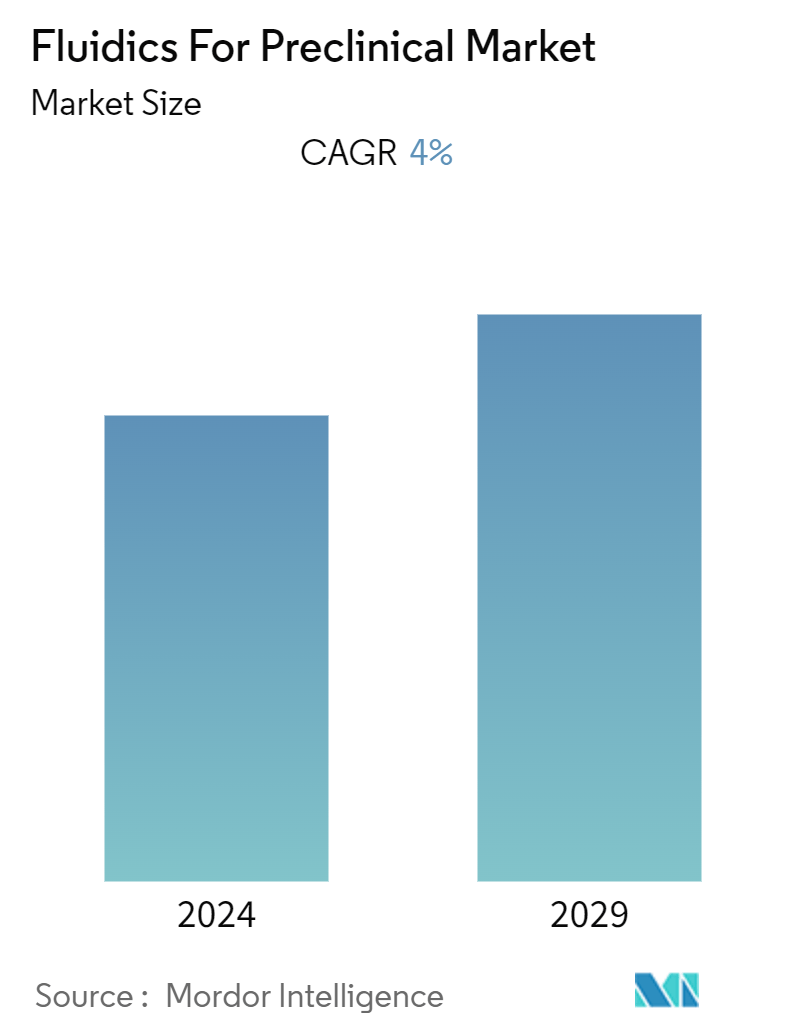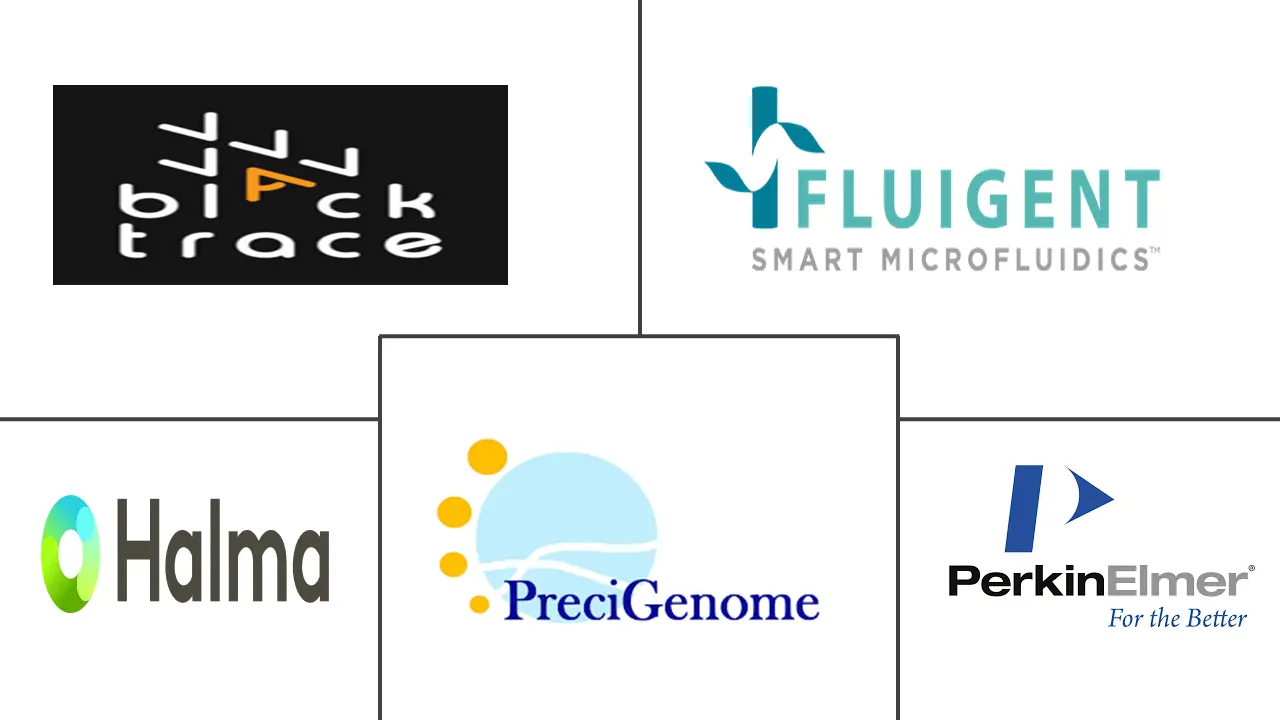Market Size of Fluidics For Preclinical Industry

| Study Period | 2019 - 2029 |
| Base Year For Estimation | 2023 |
| CAGR (2024 - 2029) | 4.00 % |
| Fastest Growing Market | Asia Pacific |
| Largest Market | North America |
| Market Concentration | Medium |
Major Players
*Disclaimer: Major Players sorted in no particular order |
Fluidics for Preclinical Market Analysis
The Fluidics For Preclinical Market is expected to register a CAGR of 4% during the forecast period.
COVID-19 has impacted market growth owing to the lockdown measures imposed by the government, leading to the disruption of preclinical research, which has impacted the market growth during the initial phase of the pandemic. In early 2020, with increasing COVID-19 cases, companies focused on conducting preclinical research to develop mRNA-based vaccines against coronavirus, which has increased the demand for fluidics for preclinical. For instance, according to an article published in the Life Journal in May 2022, it has been observed that SARS-CoV-2 antibodies were detected using a variety of methods, including the microfluidic DA-D4 (double-antigen bridging immunoassay technique), which finds total antibodies, including all subclasses and isotypes, and sandwich/competitive immune-sensors based approaches, and enable the analysis of three samples per device. Also, as per the same source, the semi-automated microfluidic platform with the traditional multilayer soft-lithography technology can detect antibodies against four SARS-CoV-2 antigens while processing 50 samples in a single device. Thus, the high utilization of fluidics techniques for detecting coronavirus increased the market growth during the pandemic. Moreover, with the increasing number of drug development processes, the studied market is anticipated to grow over the forecast period.
Factors such as the growing preclinical research and the increasing incidences of chronic diseases are expected to boost market growth over the forecast period.
The rising burden of chronic diseases such as cancer, diabetes, cardiovascular diseases, and others increases the demand for point-of-care testing and novel drugs, which is expected to propel the demand for fluidics for the preclinical market over the forecast period. For instance, according to the 2022 statistics published by IDF, about 537 million people were living with diabetes in 2021, which is projected to reach 643 million and 784 million by 2030 and 2045, respectively. This is anticipated to increase the demand for testing using microfluidic chips and small samples of blood, hence boosting the market's growth.
Additionally, as per 2022 statistics published by Dementia Australia, 401,300 Australians were living with dementia in Australia in 2022, and this number is projected to reach about 849,300 million (533,800 women and 315,500 men) by 2058. Thus, the increasing burden of dementia among the target population raises the need for effective drug discovery, screening methods, and toxicology studies. This increases the demand for fluidics systems or software that can be used to grow neurites, glial cells, endothelial cells, and skeletal muscle cells, along with the maintenance of fluid isolation, and provides an opportunity to investigate organogenesis and disease etiology.
Furthermore, the increasing facility and investment for preclinical research studies are also contributing to the market growth. For instance, in October 2022, the Minister for Municipal Administration and Urban Development, Industries and Commerce, and Information Technology, India, inaugurated the state-of-the-art facility of the GV Safety Assessment Platform (GVSAP), preclinical services vertical of GV Research Platform (GVRP) involved in commercial breeding of Specific Pathogen Free (SPF) research models and preclinical testing in Hyderabad. Also, in April 2022, The National Growth Fund in the Netherlands invested EUR 325 million (USD 345 million) to accelerate the preclinical development process of cancer drugs. With this investment, Oncode-PACT will develop valuable drug candidates faster and cheaper, which is anticipated to augment the market growth over the forecast period.
Therefore, owing to the aforementioned factors, such as the high burden of diabetes and dementia among the population and the increasing investment in preclinical research, the studied market is anticipated to grow over the forecast period. However, the stringent regulatory framework is likely to hinder the growth of the fluidics for the preclinical market over the forecast period.
Fluidics for Preclinical Industry Segmentation
As per the scope of the report, fluidics for preclinical is a combination of science and technology, which is used in studying the behavior of fluids through microchannels. It manipulates and controls fluids in a network of channels with dimensions from tens to hundreds of micrometers. The fluidics for the preclinical market is segmented by product type (software and accessories and precision syringe pumps), application (life science research and clinical application), and geography (North America, Europe, Asia-Pacific, and the rest of the world). The report offers the value (in USD) for the above segments.
| By Product | |
| Software and Accessories | |
| Precision Syringe Pumps |
| By Application | |
| Life Science Research | |
| Clinical Application |
| Geography | ||||||||
| ||||||||
| ||||||||
| ||||||||
| Rest of the World |
Fluidics For Preclinical Market Size Summary
The fluidics for the preclinical market is poised for growth, driven by the increasing demand for advanced research methodologies and the rising incidence of chronic diseases. The market has experienced a resurgence due to the heightened focus on preclinical research during the COVID-19 pandemic, particularly in the development of mRNA-based vaccines, which underscored the importance of fluidics technologies. The growing burden of diseases such as cancer, diabetes, and cardiovascular conditions is propelling the need for point-of-care testing and novel drug development, thereby boosting the market's expansion. Additionally, investments in preclinical research facilities and the adoption of innovative technologies, including AI-driven solutions, are further contributing to the market's growth trajectory.
North America is expected to dominate the fluidics for the preclinical market, supported by a robust healthcare infrastructure and a significant number of researchers engaged in preclinical studies. The region's focus on developing effective therapeutics to address the high prevalence of chronic diseases is a key driver of market growth. The establishment of new research centers and the introduction of cutting-edge products are also enhancing the market landscape. Despite the market's potential, challenges such as stringent regulatory frameworks may pose obstacles to growth. The market remains consolidated, with key players like Blacktrace Holdings Ltd., Fluigent SA, and PerkinElmer Inc. leading the charge in innovation and development.
Fluidics For Preclinical Market Size - Table of Contents
-
1. MARKET DYNAMICS
-
1.1 Market Overview
-
1.2 Market Drivers
-
1.2.1 Growing Preclinical Researches
-
1.2.2 Increasing Incidence of Chronic Disorders
-
-
1.3 Market Restraints
-
1.3.1 Strignent Regulatory Framework
-
-
1.4 Porter's Five Forces Analysis
-
1.4.1 Bargaining Power of Suppliers
-
1.4.2 Bargaining Power of Buyers/Consumers
-
1.4.3 Bargaining Power of Suppliers
-
1.4.4 Threat of Substitute Products
-
1.4.5 Intensity of Competitive Rivalry
-
-
-
2. MARKET SEGMENTATION (Market Size by Value - USD million)
-
2.1 By Product
-
2.1.1 Software and Accessories
-
2.1.2 Precision Syringe Pumps
-
-
2.2 By Application
-
2.2.1 Life Science Research
-
2.2.2 Clinical Application
-
-
2.3 Geography
-
2.3.1 North America
-
2.3.1.1 United States
-
2.3.1.2 Canada
-
2.3.1.3 Mexico
-
-
2.3.2 Europe
-
2.3.2.1 United Kingdom
-
2.3.2.2 Germany
-
2.3.2.3 France
-
2.3.2.4 Italy
-
2.3.2.5 Spain
-
2.3.2.6 Rest of Europe
-
-
2.3.3 Asia-Pacific
-
2.3.3.1 China
-
2.3.3.2 Japan
-
2.3.3.3 India
-
2.3.3.4 Australia
-
2.3.3.5 South Korea
-
2.3.3.6 Rest of Asia-Pacific
-
-
2.3.4 Rest of the World
-
-
Fluidics For Preclinical Market Size FAQs
What is the current Fluidics for Preclinical Market size?
The Fluidics for Preclinical Market is projected to register a CAGR of 4% during the forecast period (2024-2029)
Who are the key players in Fluidics for Preclinical Market?
Blacktrace Holdings Ltd., Fluigent SA, Halma Plc, Precigenome LLC and PerkinElmer Inc. are the major companies operating in the Fluidics for Preclinical Market.

